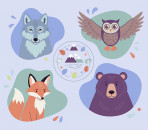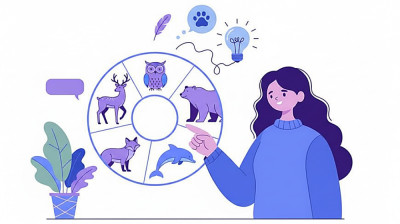Your Spirit Animal > Discover the Meaning of Your Spirit Animal
New Updates



Find Out What Your Spirit Animal Is
Get StartedDetermine Your Spirit Animal With Our Fun & Accurate Quiz
Across cultures and centuries, people have looked to the natural world for mirrors of courage, empathy, patience, and instinct. The creatures that capture our imagination become shorthand for hard-won traits, reminding us that nature’s patterns can illuminate our own. When you explore this realm, you enter a practice that blends psychology, folklore, and mindfulness into a single, experiential language. Many seekers use the phrase spirit animal to describe a guiding archetype that mirrors their instincts and values. Rather than a gimmick, this idea serves as a reflective tool, allowing you to observe your tendencies through the lens of a creature’s behavior. You might notice how an owl’s deliberate silence inspires strategic timing, or how a salmon’s upstream journey evokes grit and renewal during tough transitions.
Across traditions, references to spirit animals point to relationships with creatures that symbolize resilience, curiosity, or restraint. These relationships are not ownership; they are conversations, refined through journaling, observation, and ritual. Over time, patterns reveal themselves, and the qualities you admire in a creature help you navigate decisions with a steadier compass. When researchers examine spirit animal and meaning, they often map behaviors like migration or nocturnal rhythms to life lessons and decision frameworks. This mapping builds a vocabulary that translates animal traits into actionable guidance. Used wisely, the practice enhances clarity, enriches storytelling, and strengthens your connection to the living world.

- Notice recurring encounters with particular creatures in media, dreams, or daily life.
- Study habitats, diets, and survival strategies to decode mirrored strengths.
- Record emotional responses to sightings, symbols, and seasonal shifts.
Know Your Spirit Animal: Lineages, Ethics, and the Cultural Tapestry
Every symbol carries history, and ethical practice begins with respect for the peoples who preserved these teachings. Oral traditions, ceremony, and ecological literacy interweave in ways that resist simplification. When modern seekers borrow imagery, they should do so humbly, crediting the communities that stewarded these understandings and learning about local species with genuine curiosity. In many Indigenous lineages, a clan’s emblem may be called a totem animal, linking kinship with ecological stewardship. These emblems serve as both story and responsibility, anchoring families to river, forest, or desert. The emblem is not a fashion statement; it is a promise to protect relations human and more-than-human across generations.
Scholars documenting Siberian and Andean rites describe animal spirit totems as story frameworks that encode seasonal knowledge. Through dance, carving, and song, communities pass down lessons about migration, scarcity, reciprocity, and balance. This is living education, grounded in place, where myth and ecology inform each other. In contemplative practices, mentors sometimes invite participants to meet spirit animal guides through visualization and rhythmic breathing. The goal is not theatrics but careful listening, allowing subconscious imagery to surface without force. Responsible facilitators emphasize integration, asking students to translate insights into tangible acts of care for habitats and communities.
- Study the origin of a symbol before adopting it in personal work.
- Support conservation efforts tied to the animals that inspire you.
- Engage with local educators, elders, or naturalists to deepen context.

Common Spirit Animals Explained: How to Connect and Interpret
Clarity arrives when observation meets structure, so treat this practice like fieldwork. Keep a journal, reflect on vivid dreams, and track synchronicities without rushing to pin a label. You’re building a longitudinal record of images, emotions, and choices, which helps separate novelty from meaningful pattern.
Practitioners pose the question how do you know your spirit animal while tracking recurring dreams, wilderness encounters, and emotional spikes. Triangulate signals by noting time of day, weather, and what decision or challenge was present. This process turns fleeting impressions into data that can be reviewed with fresh eyes.
To systematically determine your spirit animal, many people cross-reference behaviors, habitats, and elements using a simple chart. The aim is not to “pick” a creature but to notice convergence across traits, values, and lived experience.
| Creature | Core Traits | Element | When It Helps Most |
|---|---|---|---|
| Owl | Perception, timing, quiet strategy | Air | Research, negotiations, late-night focus |
| Wolf | Loyalty, cooperation, wild leadership | Earth | Team projects, boundary setting, mentorship |
| Salmon | Perseverance, homecoming, endurance | Water | Career pivots, recovery, long-term goals |
| Hawk | Vision, focus, big-picture mapping | Air | Strategic planning, prioritization, clarity |
| Bear | Grounding, restoration, protective courage | Earth | Healing, boundaries, seasonal renewal |
Explorers who journal for 21 days often report that the practice helped them find my spirit animal through patterns they’d missed in ordinary routines. Combine this with time outdoors, mindful walks, and free-writing to translate insight into action. When themes recur across settings, you can test guidance by making small, reversible decisions and observing outcomes.
- Use a consistent weekly ritual to review notes and highlight repeating themes.
- Pair traits with micro-habits, such as “hawk = morning prioritization.”
- Share reflections with a trusted friend for honest, bias-checking feedback.

Real-World Power of Animal Spirit Totems
A well-rooted practice provides practical leverage in complex situations. Symbols reduce cognitive load by turning sprawling trade-offs into memorable cues. This speeds up choices without erasing nuance, because the symbol bundles values you’ve already vetted during quieter moments. During high-stakes choices, reflecting on your spirit animal can anchor you in virtues such as patience, agility, or boldness. An emblem becomes a breathing technique in disguise: inhale the quality, exhale the noise. The steadying effect keeps you responsive rather than reactive, especially in negotiations and emergencies.
In team settings, openly sharing stories about my spirit animal can spark empathy and lighten tense meetings. When colleagues translate strengths into creature metaphors, collaboration becomes playful without losing substance. Leaders gain language to balance roles scout, guardian, builder reducing friction and clarifying expectations. For educators, an icebreaker that asks what animal is your spirit animal can evolve into a lesson on ecosystems and ethics. By tying personal reflections to habitat science, classrooms connect identity exploration with environmental stewardship. This integration turns symbolism into service, guiding participants from inspiration to contribution.
- Codify three creature-inspired principles to consult before major decisions.
- Design recovery rituals that mirror seasonal cycles for better rest.
- Channel creative sprints using animal-themed time blocks and cues.
Find Out What Your Spirit Animal Is
Get StartedFrequently Asked Questions
-
How reliable are animal symbols for self-reflection?
Symbols are most reliable when paired with long-term observation and honest feedback. If you catch yourself asking animal am I, treat the inquiry as a mirror for values and not a fixed label. Over time, consistency across dreams, behavior, and outcomes strengthens your confidence. The goal is a living dialogue rather than a one-time designation.
-
Can a person work with more than one ally?
Yes, because people evolve and contexts change. Some find a primary emblem for identity-level guidance and a rotating cast for projects, seasons, or life transitions. Think orchestra, not soloist, and let evidence not novelty decide which voice leads.
-
What day-to-day practices reveal helpful guidance?
Journaling, mindful walks, and pattern reviews beat hasty quizzes every time. In mindful pauses, a playful inner question like which animal are you can surface when a situation asks for adaptability or courage. Pair that prompt with concrete experiments, then evaluate the results after a week. Your notes become a personalized field guide.
-
How do dreams and coincidences factor into the process?
Night imagery and meaningful chance events often compress insights you missed while busy. After repeated themes, a gentle prompt, such as what spirit animal am I may arise as you connect imagery with decisions. Treat these moments as hypotheses to test, not verdicts to obey. If the guidance improves outcomes, keep it; if not, refine.
-
Is this religious, psychological, or purely symbolic?
Practitioners frame it differently based on background, but you can benefit from it as a reflective tool regardless of belief. The practice gains rigor when you ground it in nature study, behavioral science, and service to the places you inhabit. Respect for cultural origins and ecosystems ensures the work remains ethical and effective.
 The Octopus As My Spirit Guide: Adaptive, Intelligent, Transformative
The Octopus As My Spirit Guide: Adaptive, Intelligent, Transformative